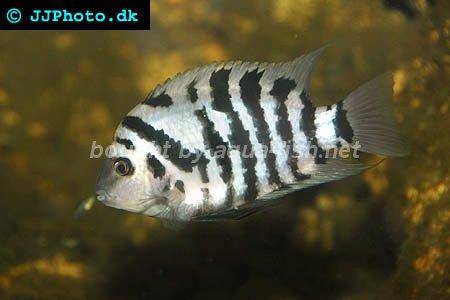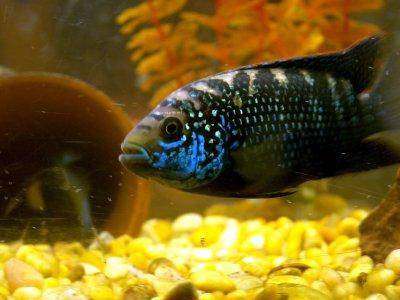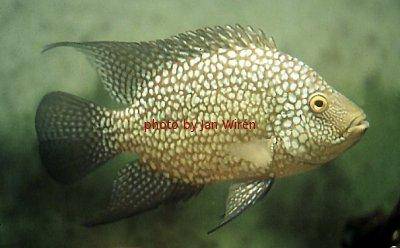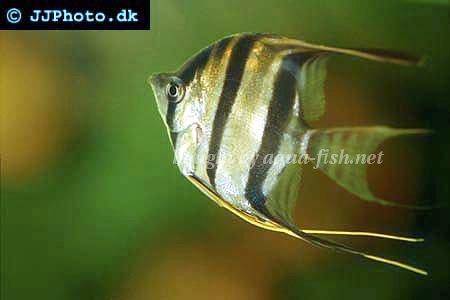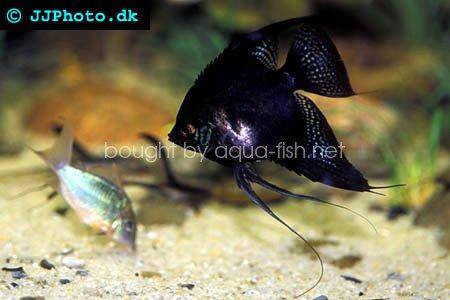Types of New World Cichlids and their description
Quick links - Answers
Brief Description
On our planet there are at least 1300 species of fish that belong to the family Cichlidae. Yet the amazing thing is that they can only be found in certain areas of the world, these are Central and South America, and Africa. These species of fish are known to everyone as cichlids and they are the most colorful and interesting fish to keep.
But why are they only found in certain areas?
The answer to this is very simple. Before the continents split to what they are today there was one super continent in the south of the planet, this was called Gondwana. This is where cichlids first evolved and as the Gondwana split 150 million years ago, the cichlids were separated. Old world cichlids are to be found on the African continent, whilst the New World cichlids inhabit Central and South America. It is believed that the lineages have been evolving into the different sub species for the last 90 million years.
Cichlids have become one of the most popular species of fish to keep in an aquarium for several reasons:-
- Most cichlids are quite easy to keep, water quality has to be maintained to a high standard, this will bring out the best colors and behavioral patterns in the fish but many cichlids can live for quite a few years.
- The different coloration to be found on the different species is quite outstanding, often when sold as juveniles, a lot of potential buyers will walk past them in the pet stores, because of this many keepers do not realize how beautiful the fish can become in time.
- A lot of fish keepers will start out fish breeding with cichlids as they will settle quickly into breeding set ups and given the right conditions will spawn many offspring. The parental care that they show to their young cannot be matched by any other fish.
- Cichlids will in time, get to know their keepers and become very tame, often accepting food from the keeper’s hand. It may take them a couple of weeks to settle into their new home but they will soon realize who is supplying them with food.
- The new world cichlids can also be split down further by separating them into dwarf cichlids, larger Amazonian cichlids, and Neotropical cichlids. These cichlids will all have there own requirements in different tank set ups and difficulty of keeping levels, research should always be carried out before purchasing the fish, mainly to make sure that the tank you have will be large enough to cope with some of the larger cichlids that can grow up to 14 inches in length.
- Dwarf cichlids tend to be quite passive, as always there are exceptions to the rule, and often these will be introduced into community aquariums. The larger cichlids can be classed as an aggressive fish with predatory natures and are often kept in species only set ups.
- As mentioned earlier New World cichlids can become quite tame, this is not just through trusting their keeper but they have quite a high intelligence level, with this comes unique personalities that keepers soon learn to love.
Nearly all of the Central and North American cichlids are monogamous, when they pair up it is a strong bond between the two. Spawning is usually confined to the substrate, often digging pits in the sand for the eggs or laying them on rocks, even in small caves.
The South American cichlids are found in very acidic, black water regions. Some of these water conditions are quite difficult to replicate in an aquarium or breeding tank, but it is possible. The pH in some of the southern regions can be as low as 6 whereas in the central and northern regions of America there are very different conditions existing in small areas, because of this, these cichlids are good at adapting to varying aquarium conditions.
NORTH AND CENTRAL AMERICAN CICHLIDS
Nearly all of the Central American cichlids belong to a group known as Cichlasomines, they can be found in all types of waterways including lakes, streams, and rivers. Stunning coloration is definitely a trademark of these fish, but the downfall to them is that they can have quite quarrelsome behavior towards other tank mates. Most of the Cichlasomines will grow up to 8 inches in length; however there are some species that will only reach 4 to 5 inches. These fish need a lot of room in the tanks; the minimum size they should be kept in is at least 48 inches. Hiding places must be included for tank mates that need a rest from the harassment that the cichlids will dish out. Most keepers will provide these with plant pots laid on their side or even terracotta piping to simulate caves, anything that will provide refuge.
Any plants added to the tank will receive the same treatment as tank mates; they will be eaten or uprooted, most keepers will not add them for this reason. Cichlasomines will tolerate a broad pH range; 7-8.5 is acceptable as they do prefer alkaline water, unlike the South American cichlids that prefer soft, acidic water.
Most conflicts occur at spawning time as the males fight for the right to mate and to maintain their territories; this is why it is crucial to have lots of swimming space for a quick retreat if necessary.
Cichlasomines will accept almost any food that is offered to them, they are voracious eaters; care must be taken not to over feed them. Live foods are ideal, chopped earthworms, insect larvae, tubifex as well as flake and pellet foods. Part of their diet should also include vegetables such as spinach or peas.
When they have spawned it is normal practice for the female to guard the eggs, fanning them while the male will defend the “nest” warding off any fish that get too close. Even when the fry are free swimming this protective behavior will continue for a short while. When the parents have spawned again it is wise to remove the original fry as they could easily become the next targets for the aggression. Several of the Central American cichlids are well known by there common names so I will now give a brief profile of a few of them, there are far too many to go into detail on them all.
Convict Cichlid
Scientific name - Archocentrus nigrofasciatus
Anyone who has kept this species of fish will know that it can hold its own against any fish, even ones that are much bigger than it is. It has earned the nick name the “aquatic rabbit” for good reason, it is almost impossible not to be successful breeding this fish. It is sometimes called the zebra cichlid due to the dark stripes that are all the way along its lavender blue body. The males usually have darker stripes than the females with a more pointed shape to the fins. The females will have pinker bellies than the males and are slightly smaller but have a rounder shape overall. Convict cichlids can tolerate a wide pH range, anything from 6.0 right up to 8.0 as long as the set pH is kept at a stable level. In my experience they are best kept in a species tank, I have always kept one male with two females, if kept with other fish they will bully the tank mates. This bullying has been known to cause death to other fish so its not worth the risk. They will accept any foods offered but a treat of vegetables and brine shrimp will improve their overall coloration. If you do decide to keep them with other species try them with Jack Dempsey’s or Red Terrors, these are about the only other species that can match their aggression. Water quality for convicts is not paramount but as with all fish the best quality you can get has to be for the good of the fish.
They are to be found in the wild mostly in Guatemala, El Salvador, Costa Rica and Panama.
If you do decide to breed these fish, plant pots laid on their sides will make excellent spawning sites for the female to lay her eggs in.
Jack Dempsey Cichlids
Scientific name - Rocio Octofasciata (Cichlasoma Octofasciatum)
For quite a few years this fish has been a favorite of many of the cichlid keepers. These are very intolerant of other fish so they are better to be kept in a species tank. The tank size is very important with these as adults they can reach a size of 10 inches in length. Because of this juvenile fish are quite happy to be kept in a tank of 48 inches but be prepared to invest in a larger tank for the adult fish. Jack Dempsey has a somewhat elongated body compared to some of the other cichlids and the males may develop a hump on the forehead as they mature. In the male fish the dorsal and anal fins are pointed; with the females the fins will be shorter and more rounded in appearance.
The coloration of the male is a base color that is dark brown but in spawning season this can change to a dark blue. On their sides they will display a very lucid blue or green dot. Their cheeks and gill covers will be covered with blue dots and the lips should be a pale blue. The female Jack Dempsey tends to display less coloration than the male.
These are yet another easy cichlid species to care for; all foods that are offered will be accepted, especially live foods. In the tank there should be plenty of hiding places like caves or rock piles, also include some driftwood to create more places for them to investigate. They will need open areas as they will spawn in pits dug into the substrate so use a fine gravel or sand. Once a breeding pair has established they should produce spawns time and time again.
Texas cichlid
Scientific name - Herichthys Cyanoguttatus
The Texas cichlid is not a fish for beginners, it is renowned for its feisty temperament but it is still a popular choice for avid cichlid keepers.
Its natural habitat is in the Rio Grande around Texas and Mexico and in the 1970’s this species was introduced to the Philippines.
As an adult it will reach a length of approx. 12 inches, bear this in mind when adding it to the aquarium, definitely nothing less than 48 inches in length. It has a wonderful golden coloration that is flecked with pearls highlights. White and turquoise dots are also scattered over the body and fins. On some of the Texas cichlids you may see three black bars on the body. In spawning season the blackness of the stripes will intensify and the belly may also darken. This fish is not so easy to sex but females tend to be smaller than the males with slightly less coloration.
A single Texas cichlid should be kept in no less than a 75 gallon tank, if keeping a pair together then you should be looking at using a 125 gallon tank at least. As with the Jack Dempsey, hiding places created from rocks and wood are ideal, try adding some plants to create small territories. The plants that are used should be quite strong and hardy as the Texas cichlid will dig burrows in the substrate which will sometimes uproot the plant life. Floating plants should be added to provide some shelter in the aquarium.
Filtration needs to be of a high standard along with plenty of water changes, as these fish are sensitive to a drop in the water quality.
They will accept most foods but add vegetables to the diet and some high protein foods like earthworms.
Eggs are normally laid on a flat surface like a rock which the parents will clean first, but be warned prior to the spawning the male may be aggressive to the female. Just before the eggs are due to hatch the parents will dig a pit in the substrate nearby, when the fry are born they will be moved into the pit while the parents keep guard.
To summarize, Central and North American cichlids tend to be very aggressive species, choose their tank mates carefully. They can tolerate a wide pH range but prefer the lower temperature scale; normally the tanks will be running at 24°C as a maximum. Most of the species are prolific breeders and show a lot of parenting skills.
SOUTH AMERICAN CICHLIDS
From all of the cichlid species the South Americans has to be my favorite. There is such a diverse range of fish, all with their own traits and personalities. Sizes of the species can vary from as small as three centimeters in length right up to 60 centimeters in length. Unlike the Central and North America cichlids, these species generally prefer soft, acidic waters and in some cases the water quality has to be of the highest of any fish kept in an aquarium. Planted tanks are more often than not advantageous with the South Americans but research the species first as some will still uproot plants and cause havoc. There are many popular species in the pet stores, the most famous has to be the angel fish, Oscars too have many fans, and my particular favorite are the discus family. Most of the species are easy to breed given the right conditions but as many generations of tank bred have reached the stores a lot of keepers miss out on the natural coloration of the wild caught fish. Most of the species are to be found in the Amazonian basin and in my experience tend to be a bit more docile than the fiery Central American cichlids.
Altum angelfish
Scientific name - Pterophyllum Altum
To me this is what an angel fish should be. I regard these as a pure angel fish species but there is a lot of debate on this subject. They are related to the common fresh water angel fish that are so easily found in the pet stores, but from my experience the Altum are a lot harder to keep, demanding the best of water conditions. They are to be found in Brazil, Venezuela and Colombia, it is not so long ago that they were thought to only exist in the Rio Orinoco but have now been discovered in a much wider area. These are definitely not fish for beginners, as mentioned above water quality has to be tops with them, they can be purchased in pet stores but demand a much higher price than the common angel fish. A true Altum can reach up to 12 “ in height so they should only be kept in tanks that have a good depth to them at least 30 inches in my opinion. Bogwood, Amazon swords and java ferns make excellent additions to the tank, if you are considering adding any other species of plants check them out first as the temperature of the tank needs to be set at 28-30°C , and with a pH ranging from 4.5-6.5 a lot of plants just will not survive. As with most Central American cichlids the water flow should be low to imitate natural conditions, these fish do not like a fast current. Sexing these fish is extremely difficult but if you do get a pair then they will prove to be very good parents, a lot better than the common angel fish. The easiest way to get breeding pairs is to add a group of 8 fish and let them pair up themselves.
Scalare Angel fish
Scientific name - Pterophyllum Scalare
Scalare angel fish are what I refer to as common angel fish; they are to be found in the pet stores in their thousands and are very popular indeed in the aquarium hobby. They do not grow as high as the Altum Angel, an adult may only reach 6 inches in height, because of this, shallower aquariums are often used to house them.
There are many variants this species as a lot of hobbyist breeders have successfully raised these; they are a bit more tolerant of water conditions. The tank set up should be the same as the Altum Angel fish although they will be quite happy with a slightly higher pH, 6.5-6.9 is ideal.
The secret with keeping the Scalare happy is to feed a varied diet, this should include flake foods, brine shrimp, mosquito larvae, and like discus fish, will enjoy a treat of minced beef heart. They will nibble at algae, in fact when I used to clean my tanks; they would follow the magnet cleaner around waiting for the algae to disperse into the water. They are not so good at parenting their fry as the Altums, but in time they do learn the basics. I found that the best way to raise the fry was to move the parents into another tank and then raise them myself.
If the Scalare are not happy with the water conditions that you provide they are prone to refuse to eat, if this occurs try doing a large water change and keep checking the parameters to make sure that they are fine.
Disease resistance is quite high in these, definitely higher than in the Altums, but if stressed they are prone to bouts of Ich.
Pike Cichlids
Pike cichlids belong to the genus Crenicichla. They are to be found all over the South American continent but most of the species inhabit the Amazonian regions where they are found in rivers, streams and lakes.
These fishes also need high temperatures in the aquarium, but as with all fish species, there are exceptions; so do your research first.
These fish are natural predators; they have an elongated body with a wide mouth. Some of the lager species will grow to 24 inches, at the other end of the scale, the dwarf species will only grow to 4 inches. They will hide in the tank waiting for their prey to swim past, and then they will lunge out chasing their prey until they grasp it. Rocks and bog wood will provide the required hiding places in the tank, adding live foods will give the fish keeper plenty of opportunity to observe this dynamic behavior. There are a couple of species that have developed their hunting techniques to catch insects on the water surface as well.
Keepers do keep Pike cichlids in planted tanks; they may up root the odd plant but in general will leave most of them alone. If you are not too sure about adding plants try out java fern or anubias attached to bogwood. Recommended tank size is no less than a 50 gallon tank, however if you do have a smaller tank try out some of the dwarf species. Strong filtration is a must with excellent water quality, if the quality drops the Pike cichlids will quickly begin to suffer or even die. As with other delicate cichlid species be prepared to do a lot of large water changes weekly to maintain the highest water quality. pH needs to be kept between 5.0 to6.0, Pike cichlids also require very soft water.
Pike cichlids are very good parents, they will lay their eggs in caves or hollows and once the fry are hatched the female will tend them while the male will guard the nest, dispersing any would be intruders. The main thing to watch with the fry is that they must be size graded into separate tanks as they develop, if not the larger fry will look at the smaller fry as meals and devour them.
Oscar cichlids
Scientific name - Astronnotus Ocellatus
Oscar cichlids are very popular in the aquarium hobby; these fish definitely have strong personalities and a high intelligence quota. I have always nick named Oscars as puppy fish due to the amount of attention that they need to keep them happy. My Oscar used to take great delight in swimming into my hand and allowing me to stroke his belly every day. If I missed a day he would get moody and decide to re-arrange the contents of the tank. They will even do wagging motions with their tails or swim in a strange fashion if they were after food. So if anyone is thinking of keeping these fish they must be prepared to spend time with it to keep it occupied or they will get bored, this could then lead to the fish having health problems. Oscars will grow big so a large aquarium is required, at least 100 gallons, in captivity they will grow up to 12 inches in length. Feeding them is definitely not as problem, they are carnivorous so will accept meaty foods with gusto; they are particularly fond of earth worms, feeder fish and beef heart. Insects should be included in their diet, crickets available from any pet store are ideal.
They are not aggressive to similar sized tank mates but never add smaller fish to the tank, these will be seen as food.
Water conditions are tolerated over a broad range but for optimum conditions they should be housed in a pH between 6.5-7.0 and soft water. Temperature should be set between 22-26°C, other than that they require no further needs.
Their natural habitat is the Amazon River, normally in the tributaries around Brazil and Paraguay.
The tank set up should be quite simple but not barren as they will move everything that they can if they are in a playful mood, they will definitely move everything if they are not happy.
In the tank I would suggest only adding a sand or gravel substrate with a few scattered rocks lying about. Check the rocks before you add them to make sure there are no sharp edges which could injure the fish. It is advisable to check the running gear in the tank daily as they will dislodge filter pipe work or internal thermometers at every opportunity.
Oscars can be bred in the aquarium, but be warned if you are thinking of doing this. They lay a lot of eggs in the wild as the mortality rate is high, it is slightly better in the aquarium but a lot of eggs/fry will still be lost.
Sexing the fish is not easy; they look exactly the same, the only true way of knowing if you have a female is if she lays eggs. Buying a group of Oscars and letting them pair on their own is the only way of getting a pair for a breeding project. They need to lay their eggs on a flat rock or something similar, if this is not provided they will dig a pit in the substrate until the glass is showing and then lay their eggs there. Patience is definitely a virtue with these fish; they will go through their mating rituals for months before they decide to lay. Jaw locking and chasing each other around the tank are a couple of give away signs to look for.
The conclusion
I could go on for ever describing the various species of New World cichlids, there are so many to choose from. Several good publications are available that will supply lots of information about keeping these fish, do lots of research before you buy.
Make sure that the aquarium you have will be large enough to house the species that you are interested in keeping.
Always be aware that the Central and North American cichlids will show quite a lot of aggression to their tank makes, so be prepared for it.
The South American cichlids will generally all require very acidic water, if your mains water is too alkaline it may be a good idea to invest in a reliable RO (reverse osmosis) unit, these will lower the pH of your water but it will need to be re-mineralized to be able to support your fish.
You may have noticed that I haven’t included a brief description about discus in this article, the reason for this is that there is already an excellent article on this website that I strongly recommend you read through.
Questions&answers
On March 24th 2011 the following answers were moved here due to merging aqua-fish.net/answers with related pages. You're welcome to submit your own questions too, use a form at the bottom of this page, please!
-
Which South American cichlids are compatible?
Answer: Most SA cichlids are compatible; they are also aggressive and territorial. If mixing different species together they will need a large enough tank to form their own territories. Try to avoid adding small cichlids to the large species.
-
Which rift valley lake cichlids are easiest to keep?
Answer: The truth is, all rift valley cichlids are easy to keep. Some are more aggressive than others but they are all very hardy and non-demanding of water conditions. They all accept any foods offered to them and they are each very pleasing to the eye in their own unique ways.

